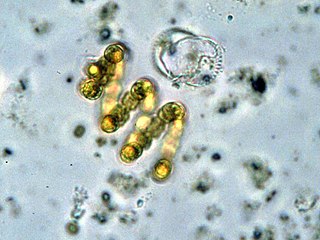Halotolerance is the adaptation of living organisms to conditions of high salinity. Halotolerant species tend to live in areas such as hypersaline lakes, coastal dunes, saline deserts, salt marshes, and inland salt seas and springs. Halophiles are organisms that live in highly saline environments, and require the salinity to survive, while halotolerant organisms can grow under saline conditions, but do not require elevated concentrations of salt for growth. Halophytes are salt-tolerant higher plants. Halotolerant microorganisms are of considerable biotechnological interest.

Cyanobacteria, also known as Cyanophyta, are a phylum consisting of free-living photosynthetic bacteria and the endosymbiotic plastids, a sister group to Gloeomargarita, that are present in some eukaryotes. They commonly obtain their energy through oxygenic photosynthesis. The oxygen gas in the atmosphere of earth is produced by cyanobacteria of this phylum, either as free-living bacteria or as the endosymbiotic plastids. The name cyanobacteria comes from the color of the bacteria. Cyanobacteria, which are prokaryotes, are also called "blue-green algae", though some modern botanists restrict the term algae to eukaryotes. Cyanobacteria appear to have originated in freshwater or a terrestrial environment.

Lyngbya is a genus of cyanobacteria, unicellular autotrophs that form the basis of the oceanic food chain.
Gloeocapsa is a genus of cyanobacteria. The cells secrete individual gelatinous sheaths which can often be seen as sheaths around recently divided cells within outer sheaths. Recently divided cell pairs often appear to be only one cell since the new cells cohere temporarily. They are also known as glow caps, a term derived from the yellowish hue given off by the cap.

Cyanotoxins are toxins produced by bacteria called cyanobacteria. Cyanobacteria are found almost everywhere, but particularly in lakes and in the ocean where, under high concentration of phosphorus conditions, they reproduce exponentially to form blooms. Blooming cyanobacteria can produce cyanotoxins in such concentrations that they poison and even kill animals and humans. Cyanotoxins can also accumulate in other animals such as fish and shellfish, and cause poisonings such as shellfish poisoning.

The Nostocaceae are a family of cyanobacteria that forms filament-shaped colonies enclosed in mucus or a gelatinous sheath. Some genera in this family are found primarily in fresh water, while others are found primarily in salt water. Other genera may be found in both fresh and salt water. Most benthic algae of the order Nostocales belong to this family.

Spirillum is a genus of Gram-negative bacteria in the family Spirillaceae of the Nitrosomonadales of the Betaproteobacteria. There are two species of Spirillum with validly or effectively published names - Spirillum winogradskyi and Spirillum volutans.

An akinete is an enveloped, thick-walled, non-motile, dormant cell formed by filamentous, heterocyst-forming cyanobacteria under the order Nostocales and Stigonematales. Akinetes are resistant to cold and desiccation. They also accumulate and store various essential material, both of which allows the akinete to serve as a survival structure for up to many years. However, akinetes are not resistant to heat. Akinetes usually develop in strings with each cell differentiating after another and this occurs next to heterocysts if they are present. Development usually occurs during stationary phase and is triggered by unfavorable conditions such as insufficient light or nutrients, temperature, and saline levels in the environment. Once conditions become more favorable for growth, the akinete can then germinate back into a vegetative cell. Increased light intensity, nutrients availability, oxygen availability, and changes in salinity are important triggers for germination. In comparison to vegetative cells, akinetes are generally larger. This is associated with the accumulation of nucleic acids which is important for both dormancy and germination of the akinete. Despite being a resting cell, it is still capable of some metabolic activities such as photosynthesis, protein synthesis, and carbon fixation, albeit at significantly lower levels.

Planktothrix is a genus of filamentous cyanobacteria. P. agardhii is regarded as a type species of the genus. Like all the Oscillatoriales, Planktothrix species have no heterocyst and no akinetes, but are unique because they are planktonic, solitary trichome and have gas vacuoles. Before the work of Suda et al., some species of the taxon were grouped within the genus Oscillatoria. A tremendous body of work on Planktothrix ecology and physiology has been done by Anthony E. Walsby, and the 55.6 kb microcystin synthetase gene have been sequenced.

Lyngbya majuscula is a species of filamentous cyanobacteria in the genus Lyngbya.
Methanogenium marinum is a psychrophilic, H2-using methanogen from Skan Bay, Alaska. Its cells are highly irregular, non-motile coccoids, occurring singly. AK-1 is its type strain.
Thermocrinis ruber is a species of bacteria. It is a pink-filament-forming hyperthermophilic bacterium first isolated from Yellowstone National Park. Its cells are gram-negative and grow at temperatures up to 89 °C. Its type strain is OC 1/4 [= DSM 12173].
Thermotoga subterranea is a thermophilic, anaerobic, non-spore-forming, motile and Gram-negative bacterium, with type strain SL1.
Halanaerobacter chitinovorans is a species of bacteria, the type species of its genus. It is a halophilic, anaerobic, chitinolytic bacterium. Its cells are long, gram-negative, motile, flexible rods.
Sphingomonas stygia is a species of bacteria. It is an aromatic compound-degrading bacteria, it is gram-negative, non-spore-forming, non-motile and rod-shaped. It is found in deep-terrestrial-subsurface sediments.
Desulfitobacterium metallireducens is an anaerobic bacterium that couples growth to the reduction of metals and humic acids as well as chlorinated compounds. Its type strain is 853-15A(T). It was first isolated from a uranium-contaminated aquifer sediment.
Zymophilus paucivorans is a species of anaerobic, Gram-negative, rod-shaped bacteria first isolated from spoilt beer. It is the type species of its genus.
Psychroflexus tropicus is an obligately halophilic Cytophaga–Flavobacterium–Bacteroides group bacterium. It is Gram-negative, fine rod- to short filament-shaped, with type strain LA1T.
Desulfotomaculum thermoacetoxidans is an obligately anaerobic, thermophilic, spore-forming sulfate-reducing bacterium with type strain CAMZ.
Leucothrix is a genus of large, filamentous bacteria, which live as epiphytes in marine habitats.








